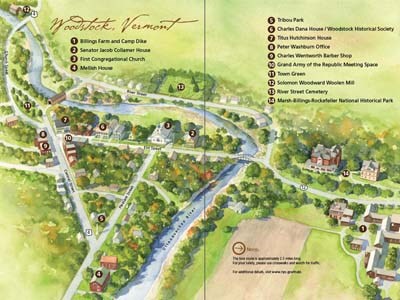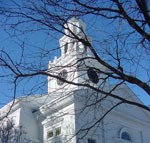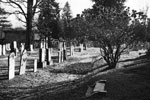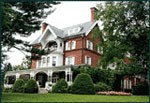
This walking tour, piloted in the fall of 2003, is the first interpretive program in the National Park System devoted to the civilian experience of the Civil War. "There are 38 units of our national park system interpreting the American Civil War," according to Dwight Pitcaithley, former NPS Chief Historian. "What makes the Woodstock tour so important is that it [is] the first-ever exclusively focused on the Home Front and the broader social context of the war. This is ground-breaking." If you would like to explore the walking tour route on your own, download the self-guiding booklet Civil War Home Front Walking Tour brochure, Causes and Consequences. 
NPS Photo Woodstock was one of the most important home front communities in Vermont during the Civil War, a conflict in which Vermont played an outsized role given its modest size and population. "You can't have Gettysburg, Antietam and Manassas without Woodstocks," says Howard Coffin, a Woodstock native and author of three books on Vermont's Civil War history. "I don't know a better place in the northern states to examine home front history." Most of the buildings along the tour route through the village center were standing when the first shot was fired on Fort Sumter in April 1861. The tour route includes some of the most significant historic sites in Woodstock. For example: 
NPS Photo 
NPS Photo 
NPS Photo 
NPS Photo Visit Saint-Gaudens National Historical Park in Cornish, NH to learn more and to visit the Shaw Memorial immortalizing the 54th Massachusetts Regiment. 
NPS Photo Marsh-Billings-Rockefeller National Historical Park: Boyhood home of conservationist George Perkins Marsh, who argued the Union cause in Europe as Lincoln's ambassador to Italy. The property later passed into the hands of Frederick Billings, whose circle of friends successfully pressed for the preservation of Yosemite in the midst of the Civil War - a monument to national unity and the cornerstone of a postwar republic strengthened by conservation and national parks. 
Booklet Recieves Award - Read the Press ReleaseMarsh-Billings-Rockefeller National Historical Park is pleased to make available a Civil War home front history resource, a 32-page, illustrated booklet titled, A New Birth of Freedom: A Walk Through the Civil War Home Front in Woodstock, Vermont. Visitors can use the booklet to take a self-guided walking tour of the town of Woodstock that highlights local contributions to the war. Woodstock was home to the state's chief military administrative officer, the Adjutant General, making it the center of Vermont's war effort. Woodstock was also home to several other important figures during the war: Senator Jacob Collamer, one of President Lincoln's key allies in the senate; George Perkins Marsh, the minister to Italy during the war, who helped keep European nations from supporting the Confederate cause; Frederick Billings, who raised impressive sums of money for the Sanitary Commission to improve the lives of soldiers; and eleven African American soldiers who fought with the famed Massachusetts 54th Regiment. The impact of the Civil War on the concept of public lands and conservation is also explored. The booklet, designed by Wood Ronsaville Harlan, Inc. and written by Jill Jasuta, was completed through a project agreement with Harpers Ferry Center. You can download a PDF version of the booklet here. |
Last updated: July 8, 2023
